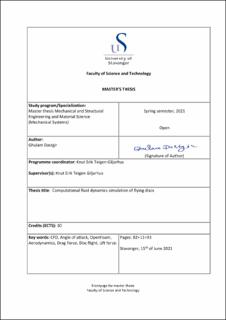| dc.description.abstract | This manuscript is divided in two parts. First, a comprehensive review of flight dynamics and disc-wing aerodynamics literature is presented. It discusses the aerodynamic characteristics of circular planform wings and the flight dynamic characteristics. Second, a numerical study is conducted in order to study the flow fields around the wing discs and to validate the effectiveness of the computational fluid dynamics (CFD) techniques on the multiple disc designs. The characteristics which were under consideration are the aerodynamic forces (mainly lift and drag forces), pressure & velocity distribution on the surface of the disc and in the surrounding field, moment coefficients, and the flow field variations. The numerical results were compared with the experimental results to verify the accuracy and the validity of the simulations. This comparison showed clear similarity of numerical estimations with the experimental data proving the capacity of the model to simulate disc aerodynamics with accuracy. The computational analysis was carried out also on three types of discs including Putter, Midrange, and Aviar discs models. The results were compared to experimental work as before showing also a good accuracy between numerical and experimental data.
Different turbulence models (RANS, LES and DDES) were tested and compared. The outcomes obtained from the comparison of RANS and LES models of turbulence show both turbulence models may present different flow topologies. By its characteristics RANS model may generate steadier flow than the LES model but the latest demands higher computational effort. Furthermore, a comparison of RANS and DDES turbulence models was also made to observe the behavior of the aerodynamic coefficients. The results obtained showed some deviation from the experimental data. However, despite these differences model has sown to well compute aerodynamics of the disc over different geometries. Finally, the standard RANS KOmegaSST model may present good accuracy comparing to experimental data but the study of the flow structures over the surface of the discs might be examined and improved with DDES KOmegaSSTDDES model instead. | |
